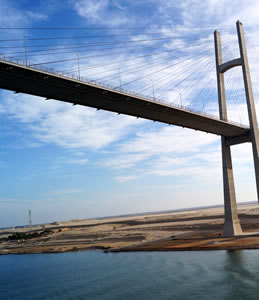Suez Canal Blocked! Time to go 3D?
The 2020 pandemic affected ships and crews,
Argentina saw the most disruptive labour disputes of the last several years.
The Suez canal is obstructed by a ship gone aground, affecting over 300 ships.
…Sounds as if the black swan developed into a colony!
And the list goes on…
There are many ways in which a delay can affect a voyage, and with it the flow of income, and it is always surprising (and frustrating) to see that the consciousness of there being tools to hedge against such delays only surfaces when the heat starts burning the earnings. It should be in the insurance program of every ship operator before an event occurs!
Generally speaking, the two main (and de facto mandatory) dimensions of shipowners’ risk management concern the protection against physical damages (H&M) and Liabilities (P&I).
"They have in common the exclusion for loss of earnings."
Whilst this type of loss is excluded by H&M and by P&I, it can be covered through a loss of hire cover, but a loss of hire cover can only be triggered by a H&M claim and does not insure it below 14 days, and the first 14 days are the most painful!
Nordic’s Primary Layer Delay cover is designed to mirror the exclusions (H&M and P&I) and limitations (LoH) of mainstream covers. It adds a third dimension to an operator’s insurance landscape which brings added value without added burden!
Let’s look at the recent incident in the Suez Canal through a 3D perspective.
This incident is a good example of the ways in which considerable earnings can be eroded, and the ways in which our primary layer delay cover works.
The ships awaiting to transit the canal
The operators of the ships that are blocked will have to bear the costs during the delay.
Owners operating on spot market basis will exceed the estimated duration of voyage, most probably without having the opportunity to adjust the freight amount.
Time Charterers operating a chartered in ship will not be able to put the ship off-hire and will therefore have to keep paying hire to the owner of the ship, whilst not benefiting from the ship.
The grounded ship
It is already clear at this stage that the event will give rise to a H&M claim, which in turn means that if mainstream LoH cover is in place the owner will only recover the declared earnings from the 15th day onwards, up to the agreed single event limit.
The owner of the grounded ship therefore will lose the earnings for the first 14 days.
The majority of Nordic Marine clients are ship owners and the majority of perils insured against are the ship related perils, both H&M and P&I.
Our Primary layer delay cover, therefore, would respond and protect the primary level of lost earnings for both the grounded ship as well as for the ships awaiting to transit the canal.
—–


